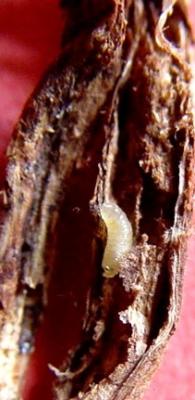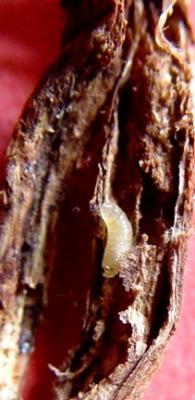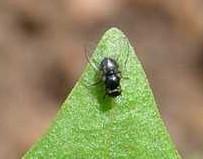


Bean flies (<i>Ophiomyia phaseoli</i> and related species)
Bean flies are tiny about 2 mm long, shiny black-bluish in colour. They can cause serious stand reductions at the seedling stage. Bean flies lay eggs in punctures of leaves near the petiole. The small white maggots feed inside the main stem just above the soil line. Pupation occurs inside the stem. The life cycle may be completed rapidly, often in less than 2 weeks.
Seedlings attacked by bean flies may wilt or die. Leaves of older plants may be yellow and stunted. Stems are thicker than normal and cracked lengthwise just above the soil. Maggot feeding facilitates the entry of disease-causing microorganisms leading to secondary infections. In cases of heavy infestation, many plants die. Bean flies are important only during the seedling stage (up to 4 weeks after germination).
- Plant early in the season. Bean fly numbers tend to be low during the early stages of the growing season and increase with time.
- Plant after green manure crop.
- Avoid planting near cowpea, beans and other leguminous crops, that may be the source of bean flies.
- Practise crop rotation with non-legumes such cereals.
- Ridging the plants 2-3 weeks after germination helps to cover the adventitious roots produced by plants damaged by bean flies (these roots grow directly from stems and/or leaves). The soil support prevents lodging and improves the survival of the damaged plants.
- Mulch with rice straw. The mulch covers the seed leaves (cotyledons) making them inaccessible for egg laying.
- If necessary, spray neem extracts. Frequent foliar applications of neem extract give satisfactory control of bean flies.
- Remove and destroy crop residues and all plant parts with symptoms of damage by bean flies.
